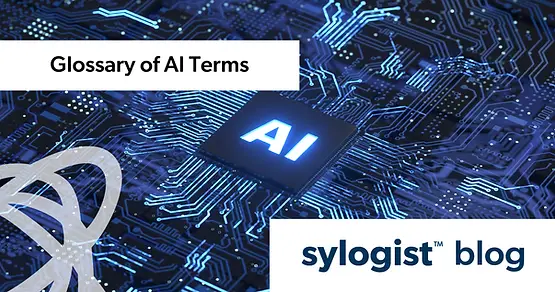2024 TRENDS – AI for Nonprofits 102 – A Lesson in Vocabulary

The ultimate glossary of the key terms, words, and phrases you need to know as a leader interested in AI for nonprofits.
Algorithm: a step-by-step set of instructions or rules that a computer follows to perform a specific task. In the context of AI, algorithms play a crucial role in processing and analyzing data to generate meaningful insights or predictions. Nonprofit leaders should be aware of the algorithms used in their AI applications to ensure transparency and ethical use.
Ambiguity Resolution: Natural language is inherently ambiguous, with words and phrases often having multiple meanings. AI systems must employ sophisticated algorithms to resolve ambiguity and deduce the most likely interpretation based on context.
Artificial Intelligence (AI): the development of computer systems that can perform tasks that typically require human intelligence. These tasks include learning, reasoning, problem-solving, perception, language understanding, and even decision-making. AI technologies encompass a range of approaches, from rule-based systems to machine learning and deep learning.
Bias: refers to the presence of systematic and unfair distinctions or preferences within the data or algorithms, leading to biased outcomes. Nonprofit leaders must prioritize addressing bias in AI systems to ensure equitable and inclusive results, especially when working on projects with social impact.
Blockchain: a decentralized and distributed digital ledger technology that records transactions across multiple computers in a secure and tamper-resistant manner. It is designed to enable transparent and trustless peer-to-peer transactions without the need for a central authority or intermediary.
Chatbot: (short for “chat robot”) a computer program designed to simulate conversation with human users, especially through text or voice interactions. Chatbots are often used in various applications to provide information, answer queries, perform tasks, or engage in conversation in a natural language format. They can be implemented on websites, messaging platforms, mobile apps, and other communication channels.
ChatGPT: is a language model developed by OpenAI, based on the GPT (Generative Pre-trained Transformer) architecture. It is designed to generate human-like text responses in a conversational style. ChatGPT is an extension of OpenAI’s earlier models, such as GPT-3, and is fine-tuned specifically for natural language understanding and generation in a chat-based setting.
Cloud technology: often referred to as cloud computing, is a paradigm that involves the delivery of computing services, including storage, processing power, software, and networking, over the internet. Instead of relying on local servers or personal devices to handle computing tasks, users can access and use resources hosted on remote servers provided by cloud service providers.
Co-boting: using AI technology to augment a job, rather than replace the human responsible for said job.
Context Awareness: Understanding context is essential for accurate language comprehension. NLP models must consider the broader context of a conversation or document to interpret ambiguous language and respond appropriately.
Copyright: protect original works of authorship, such as literary, artistic, and musical works. This protection allows creators to control how their works are reproduced, distributed, performed, and displayed. Copyrights typically last for the lifetime of the author plus a certain number of years.
Cyber-Physical Systems (CPS): refer to integrated systems that seamlessly blend computational algorithms and physical processes. These systems represent the convergence of the digital and physical worlds, where computational elements interact closely with physical components to monitor, control, and automate various processes.
Data Privacy: a critical aspect of AI implementation. Nonprofit leaders must ensure compliance with data protection regulations and establish robust practices for handling and securing sensitive information. This is particularly important when dealing with personal data in areas such as donor management or beneficiary services.
Deep Learning: a specialized form of machine learning that involves neural networks with multiple layers (deep neural networks). This approach is particularly effective in handling complex tasks such as image and speech recognition. Nonprofit leaders should recognize the potential of deep learning for solving intricate challenges but also be mindful of the computational resources it requires.
Ethical AI: involves the responsible and fair development and deployment of AI technologies. Nonprofit leaders should prioritize ethical considerations, including transparency, accountability, and inclusivity, to avoid unintended consequences and build trust among stakeholders.
Generative AI: short for Generative Artificial Intelligence, refers to a class of artificial intelligence systems designed to generate new, original content autonomously. These systems use various algorithms, often based on machine learning techniques, to create data, images, text, or other forms of content that are not directly copied from existing examples. Unlike traditional AI systems that rely on explicit programming and predefined rules, generative AI has the ability to produce novel outputs by learning patterns and structures from the input data it has been trained on.
Hallucinations: in the context of artificial intelligence (AI), the term “hallucinations” is used to describe instances where AI systems generate outputs or predictions that are incorrect, misleading, or diverge significantly from reality. Hallucinations in AI models may occur due to various reasons, including biases in the training data, overfitting, or limitations in the algorithms themselves.
Intellectual Property (IP): refers to creations of the mind, such as inventions, literary and artistic works, designs, symbols, names, and images used in commerce. Intellectual property is protected by law through patents, copyrights, trademarks, and trade secrets, which enable creators and innovators to control the use of their creations or inventions for a certain period.
Language Generation: involves the ability of AI systems to produce human-like language. This capability is utilized in applications such as chatbots, content creation, and automated report writing.
Machine Learning (ML): a subset of AI that focuses on enabling machines to learn from data without being explicitly programmed. Nonprofit leaders should understand that ML algorithms can identify patterns and make predictions or decisions based on the data they have been trained on. This technology is particularly valuable for tasks such as predictive analytics, image recognition, and natural language processing.
Machine Translation: AI systems translating text or spoken language from one language to another. This is valuable for breaking down language barriers in various applications.
Natural Language Processing (NLP): a subfield of artificial intelligence (AI) that focuses on enabling machines to understand, interpret, and generate human language in a way that is both meaningful and contextually relevant. Natural language, in the context of AI and NLP, refers to the language humans use for communication, such as English, Spanish, or Chinese.
Patent: grants inventors exclusive rights to their inventions, preventing others from making, using, or selling the patented invention for a specified period (usually 20 years). In return for this exclusive right, the inventor must disclose the details of the invention to the public.
Reskilling: the process of learning new skills or acquiring additional competencies to transition into a different role or adapt to changes in the job market. Unlike upskilling, which typically involves enhancing existing skills, reskilling implies a more significant shift in one’s skill set to meet the requirements of a new job or career path.
Semantics: the meaning of words and sentences. AI models must grasp the intended meaning of words in different contexts to accurately process and respond to language.
Syntax: the structure of sentences and the rules governing the arrangement of words. AI systems need to understand the grammatical structure to comprehend the meaning of a sentence.
Speech Recognition: a crucial component of natural language processing, enabling AI systems to transcribe spoken language into written text for further analysis.
Text Analysis and Understanding: AI systems use NLP techniques to analyze and understand written text, extracting information, identifying entities, and discerning sentiment or intent. This is vital for applications such as chatbots, sentiment analysis, and information retrieval.
Trademark: protects symbols, names, logos, and other identifiers that distinguish goods or services of one company from those of others. Trademark protection helps prevent consumer confusion and allows businesses to establish and protect their brand identity.
Upskilling: the process of acquiring new skills or enhancing existing ones to stay relevant and competitive in the rapidly evolving job market. The term is often used in the context of professional development, where individuals engage in learning activities to acquire the skills necessary for their current roles or to prepare for future career opportunities.
This is the third article in our series on on nonprofit fundraising trends for 2024, we explore the trends that we expect to dominate 2024 and – more importantly – we’ll explore the best ways for nonprofits to embrace these trends.




